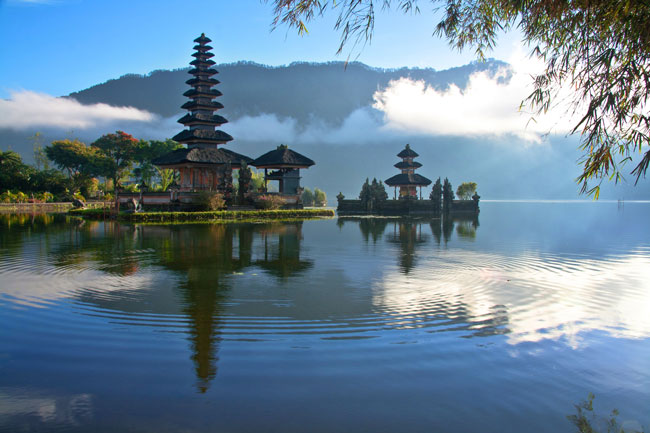
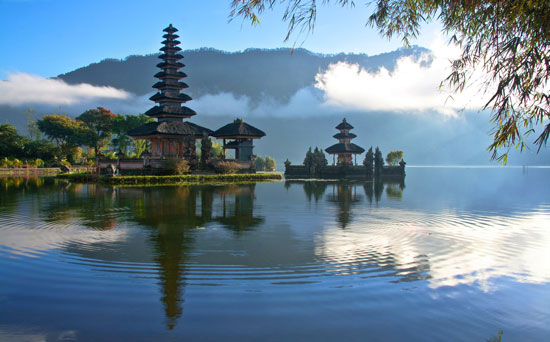
I smelled it first: Sweet incense slicing through the thick, wet, organic air. Then I saw the Balinese woman carrying the incense in a small, woven, palm leaf basket filled with rice and flowers. She placed the basket on the edge of the porch of the bungalow in which my husband and I were staying.
Her basket of blessings was an offering she made every day, no matter who was staying in the bungalow. The Balinese put offerings out every day, everywhere – in their homes, business, vehicles and on roads. Once a sacrifice is made, it’s ignored, and the stray dogs eat the rice.
But this was my first such gift, and I was amazed at how beautiful the woven leaf basket looked with the humble offerings from a people to their gods. It was the first of many blessings I would receive in Bali.
Bali is an island of Hinduism in a country of mostly Muslims. It is an oasis of dance and art in a world where commerce is the ideal. It is a mecca of temples and ceremonies in an era where religious wars are fought with automatic weapons. Even the name is musical. Bali –- where the visitor is blessed, simply by being there.
This magical location is located on a small island in Indonesia. Its community-based culture works well to keep the more than three million people happy on its 87 by 50 miles (or 140 by 80 km) land mass just south of the equator.
An active volcano, Gunung Agung, dominates the island. According to legend, the gods live on its exalted peak. From there, the holiest place on Bali, the gods watch over the pageant of Balinese life.
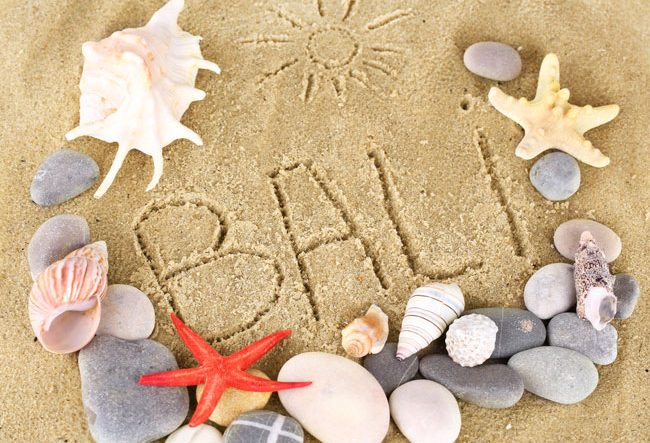 Usually visitors fly into Bali and land in Denpassar, the capitol. Most then immediately leave the city and head for the beaches, and the majority of those go to Kuta beach on the southern shores.
Usually visitors fly into Bali and land in Denpassar, the capitol. Most then immediately leave the city and head for the beaches, and the majority of those go to Kuta beach on the southern shores.
Kuta has a bad reputation, mostly for being over-run with tourists. And, of course, the 2002 terrorist bombing of the “Sari” Nightclub left a bitter taste in the region.
In some ways, Kuta is an easy introduction to Indonesia. Almost everyone speaks market English, there are umpteen lodgings to choose from, the menus feature recognizable foods, and the shopping for batiks, woodcarvings and jewelry is terrific.
But after a couple days of such ease, we headed inland to Ubud, the cultural center of Bali. The Balinese have always looked towards the mountains and away from the sea, so Kuta is not very important to them, yet Ubud is vital.
Surrounded by rice paddies, Ubud is calm and peaceful, especially after the hawkers in Kuta. In Ubud, the best thing to do is walk. Any direction will take you somewhere beautiful and interesting. Plan to stay several days. Whatever time you have, it probably won’t feel like enough.
In Ubud we discovered the soul of Bali.
The main street in Ubud is called Monkey Forest Road, and it truly leads to a monkey filled forest. The day we entered the cool woods, curious monkeys waited for handouts, while a small Balinese man swept the dirt walkways. And all the while, we could hear a faint hum. At first it seemed to be just the normal magical hum of Bali, then it grew louder and louder, and we realized something was happening.
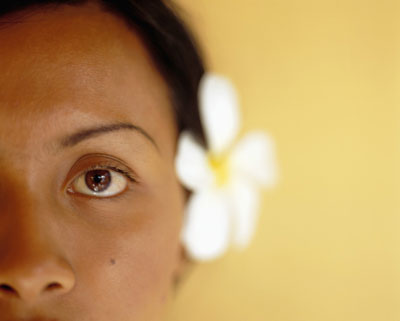 We walked up a short hill and saw a large gathering of Balinese people. Women wearing black lace blouses and yellow sarongs carried beautifully arranged fruit and foods on top of their heads. Children ran in between the adults. All along, the hum grew louder. A group of men came carrying a bamboo platform covered by a huge pink paper garuda (a mythical figure with a human torso and arms, a demonic face and a bird’s legs, wings and tail). They yelled while the women threw water on the men’s black shirts.
We walked up a short hill and saw a large gathering of Balinese people. Women wearing black lace blouses and yellow sarongs carried beautifully arranged fruit and foods on top of their heads. Children ran in between the adults. All along, the hum grew louder. A group of men came carrying a bamboo platform covered by a huge pink paper garuda (a mythical figure with a human torso and arms, a demonic face and a bird’s legs, wings and tail). They yelled while the women threw water on the men’s black shirts.
Then another platform followed on the backs of more men, this one with a white throne decorated with mirrors, flowers and silk. It was a funeral. The men spun around in an attempt to confuse any spirits who might want to prevent the dead man’s spirit from going to the gods.
Accompanying the cheering and yelling of the people was a gamelan orchestra, a surprisingly melodic music using percussion instruments such as gongs, xylophones and drums. The orchestra played in a clearing in the forest.
The top half of the garuda was removed, revealing a corpse inside. We were witnessing a cremation ceremony. It is considered a happy occasion here in Bali, as it means the deceased can now go to go be with his/her gods. Before the helpers light the body with a gas torch, the dead man’s kin wish his/her spirit a safe journey.
But it is not easy to burn things in this humid climate, and it took the torch man many tries to get the body to burn. Hours later, when all that was left is ashes, the people feasted.
Later in Ubud, we watched several traditional dances being performed for the tourists. Each dance has meaning – some represent Balinese or Hindu history; others like the Legong represent the archetype of the feminine.
It is always young girls who perform the Legong dance, their faces heavily painted, their delicate fingers arched back almost to their wrists, their eyes bold. Young men perform the Kechak dance about the monkey king, Hahnaman of Hindu mythology. Their voices are a chorus of shrieks and yells. Both dances are guided by the compelling gamelan orchestras.
I soaked in this music as I walked through the main streets of Ubud, where students learn its unusual rhythms. It was music that permeates Bali and sounds that saturated my spirit.
Long before you can begin to know what all the imagery is about and how deep the layers go, the art of Bali is working on you. The Balinese have no word for art or artist. Traditionally, art has never been regarded as something to be treasured for its own sake. Prior to the tourist invasion, art was just something you did. You painted or carved along with farming and dancing.
Although there are beautiful art and crafts to be purchased in the numerous shops, it’s the every day art that is most impressive. The funeral towers and sarcophagi at the cremation were stunning. It probably took the family a year or more to save up for such a glorious event. The over 200,000 temples on Bali are incredible works of art ranging from Beskiah, the Mother Temple, to the small family temples. The architecture and sculpture of the temples are distinctive and pure Bali.
The Balinese place great importance on the center of their islands. Perhaps it is because the volcano has so much influence over whether they live or die. The beaches are for catching fish and catering to tourists – the Balinese don’t use them for recreation like many tourists do.
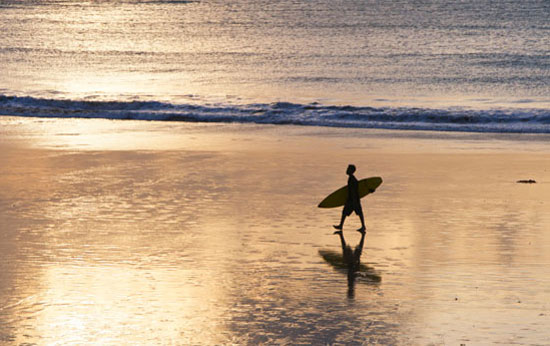
Yet the beaches are lovely. On the north side of the island are the black sand beaches of Singaraja and Lovina, good places to snorkel. We hired a small boat to take us out on the reef as dolphins splashed ahead of us. The kaleidoscope of colors, fish, corals and sunlight nearly stung my eyes. Only a few places offer excellent diving. The dive-masters, equipment and boats run on rubber time, and it’s not a place for beginners.
On the way to Candidasa, a fishing village on the southeast coast, the driver stopped to make an offering at a roadside alter. It delighted me to witness a lifestyle where people pause to honor the divine throughout their day.
The village of Tenganan, which is not far from Candidasa, holds a unique place in the world. This community is one of only few remaining villages in Bali where fraternization with outsiders is strictly prohibited. As a result, the people and a culture are very different.
The native Balinese call them Bali Aga, or Old Bali. Tenganan clings to customs and practices that predate the arrival of Hinduism. It is a neat and orderly walled village with two rows of houses up each side and facing to the center. The people here make crafts such as flutes and traditional palm-leaf books depicting old stories from bamboo. It’s also the only place where the double ikat cloth is still woven. This art form is a type of weaving where the pattern is dyed on the thread before weaving.
While the people of Bali Aga have resisted most changes, television and the electricity needed to power them have arrived. Though there’s no electricity running when tourists are in the village though; I imagine it’s hard to hear the forest sounds at night over old American “MacGyver” reruns.
In Tenganan, we strolled up the clean paths and admired the many crafts for sale. We bought a bamboo drum and a mouth harp from young men. We played bamboo flutes with an old man in his dark home, and then a woman invited us in to buy her ikat cloth. She was willing to be photographed while she weaved – for a price. She also accepted Visa.
Near the end of our stay, we stayed with other travelers on the east side of Bali, at the base of Gunung Batur, a younger sister of the mighty Gunung Agung volcano. Rising before dawn, we climbed her 3000 feet (914 meters). At the top, the crater is filled with morning mist. Young Balinese offered us tea, water and soda in the little warung (food stand) at the top. Even in hiking boots, it was a slippery, steep climb, yet I watched the Balinese run up in thongs, carrying drinks. And of course, there was an offering at the top.
Eventually, it came time to leave Bali. We went to the port village of Padangbai, on the southeast shore, to catch a ferry to the neighboring island of Lombok. After we jumped across the open water to board, I noticed an offering in yet another leaf basket on the front of the ferry.
Even our departure was blessed.
Dear Readers: This post may contain affiliate links, which means we may receive a small commission, at no cost to you, if you make a purchase through a link. All opinions are our own and we only share things we recommend. Thanks for your support.
If You Go to Bali
Indonesia and Bali Tourism
www.indonesia-tourism.com
Bali Tourism Authority
www.balitourismauthority.net
Helpful Information on Bali
Join Trusted Housesitters in Bali
Book at stay at Anantara’s luxury resort in Bali — Uluwatu Hotel
Lonely Planet: Bali & Lombok Travel Guide
Lonely Planet: Indonesia Travel Guide
